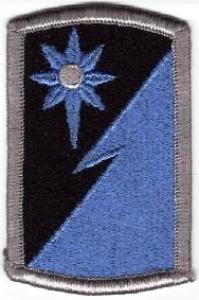Всемирная военная энциклопедия
> США
> Нашивки
> Нарукавные нашивки Сухопутных войск
> Военная разведка
> US-PTMIUS-00014

Нарукавный знак 319 бригады военной разведки СВ США
Случайные:

Кокарда знак на берет полка Легкой пехоты ВС Великобритании

Беретная нашивка 1-го эскадрона 194-го кавалерийского полка

Вышитая эмблема на фуражку ВМС Пакистана
Редактировать или перевести информацию
Description
On a rectangle arched at top and bottom with a 1/8 inch (.32 cm) gray border, 3 inches (7.62 cm) in height and 2 inches (5.08 cm) in width overall, divided beveled from upper right to lower left black above oriental blue, in upper left an oriental blue polestar pierced silver gray.
Symbolism
Oriental blue and silver gray are the colors traditionally associated with Military Intelligence units. Blue also alludes to the Pacific and the unit’s theater of operations. Black and blue suggest day and night vigilance. The polestar simulates satellite intelligence collection and communications. The jagged division of the background is reminiscent of a lightning bolt, symbolizing speed, accuracy and electronic information and systems.
Background
The shoulder sleeve insignia was approved on 18 April 1989. (TIOH Dwg. No. A-1-763)
On a rectangle arched at top and bottom with a 1/8 inch (.32 cm) gray border, 3 inches (7.62 cm) in height and 2 inches (5.08 cm) in width overall, divided beveled from upper right to lower left black above oriental blue, in upper left an oriental blue polestar pierced silver gray.
Symbolism
Oriental blue and silver gray are the colors traditionally associated with Military Intelligence units. Blue also alludes to the Pacific and the unit’s theater of operations. Black and blue suggest day and night vigilance. The polestar simulates satellite intelligence collection and communications. The jagged division of the background is reminiscent of a lightning bolt, symbolizing speed, accuracy and electronic information and systems.
Background
The shoulder sleeve insignia was approved on 18 April 1989. (TIOH Dwg. No. A-1-763)
Еще из категории: Военная разведка
 259th Military Intelligence Brigade
259th Military Intelligence Brigade
 Нарукавный знак 297 бригады военной разведки (наблюдения за театром боевых действий) СВ США
Нарукавный знак 297 бригады военной разведки (наблюдения за театром боевых действий) СВ США
 Нарукавный знак 560 бригады военной разведки (наблюдения за театром боевых действий) СВ США
Нарукавный знак 560 бригады военной разведки (наблюдения за театром боевых действий) СВ США
 Нарукавный знак 525 бригады военной разведки (наблюдения за театром боевых действий) СВ США
Нарукавный знак 525 бригады военной разведки (наблюдения за театром боевых действий) СВ США
 Нарукавный знак 300 бригады военной разведки СВ США
Нарукавный знак 300 бригады военной разведки СВ США

